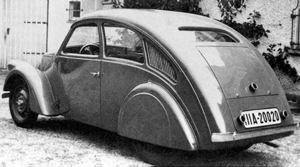Ferdinand Porsche

Ferdinand Porsche
Ferdinand Porsche was born in Maffersdorf on the 3rd September 1875, he was extremely interested in engineering and electricity (much to his fathers dismay) and by the age of 14 he was already performing experiments with electricity.
His early designs included a motorised carriage with two electric motors fitted directly to the front hubs and by 1905 Porsche was recognised as Austria's most outstanding automotive engineer
In 1906 Porsche was recruited at Austro-Daimler as their chief designer and by 1916 had progressed to Managing Director. In 1923, Porsche left Austro-Daimler and moved to Daimler who were soon to merge with Benz & Cie to become Mercedes-Benz. Porsche's ideas for a small car were not popular
at Mercedes-Benz and in 1929 Porsche left to join Steyr Automobile.
In April 1931 Porsche founded his design company in Stuttgart, where he successfully recruited several old co-workers including Erwin Komenda, Xaver Reimspiess and also his own son Ferry Porsche.
Also in 1931 the motorcyle firm Zündapp were interested in expanding their motorcycle range with a small and affordable car, Ferdinand Porsche was contracted to developed a prototype. The small cheap car has some simularities with the later Beetle, it had a backbone chassis and a rear engine (although Porsche preferred the 4-cylinder flat engine, Zündapp chose to use a water-cooled 5-cylinder radial engine).

1931 Zündapp Type 12
In financially depressed 1930's Germany, there was a growing apetite for an affordable motor car, a car for the people, or a 'volks wagen'. This idea appealed to Adolf Hitler as it would be the perfect vehicle to use on his new 'Autobahn' roads.
In 1933 Hitler appointed Porsche as the designer of the government funded 'volks wagen' and by October 1935 the first two prototypes were ready, officially designated as a Type 60 but known as the V1 and V2, the V1 being a sedan and the V2 a convertible.

V2 Prototype car
The V1 and V2 were then followed by the V3 and the VW30 as the designs were refined. The biggest design change came when it was decided that the car should have a glass rear window replacing the slotted rear, but curved glass was too expensive to produce. The solution
was a 'split' rear window with two sections of flat glass. This required that the strengthening swage lines to be re-drawn and the body designer
Erwin Komenda came up with the VW38 design that finally went into production.
As well as being interested in a cheap 'peoples car', Porsche had a passion for motor racing. In autumn 1938, the National Socialist regime announced plans for a high-speed road race from Berlin to Rome. Porsche received approval from Berlin to build three racing cars to enter into the race, the Type 64 was built and used the same running gear as the VW38 but with twin carbs and larger valves for a slightly more powerful engine and
a light weight aluminium body.
In 1939 instead of the Beetle going into full production as originally planned, Germany was at war and attention was diverted to military design. The Berlin-Rome race was cancelled and Porsche was asked to adapt the Beetle chassis and drivetrain to simple military vehicle, the 'Kübelwagen' and then the layer the amphibious 'Schwimmwagen'.
In addition to his work on the Beetle chassis, Porsche also worked on German tank designs - the Tiger I, Tiger II, the Elefant and the Panzer VIII Maus tank. Porsche also made contributions to aircraft design, including the Junkers Ju 88, and the Focke-Wulf Ta 152 and he also helped develop the V-1 'flying bomb'.

Berlin Rome Type 64
Immediately after the war in June 1945, the US Army captured Porsche and sent him to a castle in Hessen. Porsche was questioned and then released, but then arrested again along with his son Ferry by the French authorities and sent to Paris. Ferry Porsche was released after a few months, but Ferdinand Porsche was held at a Dijon prison without trial until August 5, 1947 when he was finally allowed to return home.

Porsche 356
In 1947 the Porsche company started designing a new sports car, this was to follow the Beetle's format of a rear-engined flat-four design and was given the name 356, it was to be the first vehicle to carry the Porsche name.
In the winter of 1948-1949 production of the 356 started, but the small Gmünd factory could only build five cars a month. Each hand crafted body was done by one man, when he didn't work - production stopped. Six months later, Porsche expanded to nearly 300 workers to increase production.
Ferdinand Porsche died on January 30, 1952 and hundreds of people attended his funeral.
As of 1 August 2012, Volkswagen owns 100% of the Porsche company.
More History